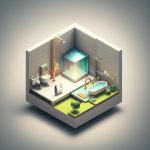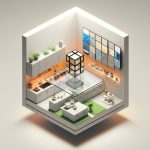Welcome to the captivating realm of interior design, where science and artistry converge. In this exploration, we’ll delve into the fascinating concept of “radiation” and how it subtly influences our environments. From the interplay of light and color to the strategic arrangement of furnishings, discover how radiation principles can transform your home into a harmonious haven.
Radiation in Interior Design: A Symphony of Energy and Flow
The term “radiation” in interior design might initially evoke images of harmful rays, but rest assured, it refers to a completely different and beneficial concept. Imagine a pebble gently disturbing the tranquil surface of a pond, creating mesmerizing ripples that gracefully emanate from the point of impact. Similarly, radiation in design involves orchestrating the flow of visual energy within a space.
At its core, radiation is about strategically positioning furniture, decor, and even color palettes around a central point, known as the focal point. This focal point acts as the visual anchor, drawing the eye and establishing a sense of balance and harmony.
What is Radiation in Interior Design?
Imagine the spokes of a bicycle wheel elegantly radiating outward from the central hub. This visual analogy perfectly captures the essence of radiation in design. It’s all about creating a sense of visual expansion and movement by arranging elements around a central point.
This central point becomes the natural focal point of the room, effortlessly drawing the eye and creating a sense of visual coherence. Picture a beautifully set circular dining table adorned with an eye-catching centerpiece. The chairs, strategically positioned around the table, naturally form this radiating pattern, making the table the undisputed star of the show.
Here’s how the concept of radiation elevates interior design:
- Instant Focal Points: A radiating arrangement effortlessly directs the eye to a chosen area, highlighting statement pieces.
- Visual Harmony: Balancing elements around a central axis creates a sense of order and visual appeal.
- Dynamic Flow: Radiating lines infuse the space with a subtle sense of movement, guiding the eye through the room in a natural and engaging way.
Here’s a glimpse into how to infuse your space with radiation:
| Element | Example |
|---|---|
| Furniture | Chairs around a round table, a sofa and armchairs gracefully encircling a fireplace |
| Lighting | Pendant lights cascading above a kitchen island, sconces elegantly framing a statement mirror |
| Color/Pattern | An area rug with a captivating radiating design, an accent wall adorned with a sunburst pattern |
| Decor | A gallery wall radiating outward from a central artwork, shelves artfully arranged to radiate from a corner |
Dive into the world of interior design by exploring naics code interior design to discover the latest industry standards and trends.
How Does Radiation Impact Interior Design, Mood, and Ambiance?
Radiation, in the context of interior design, profoundly influences the overall mood and ambiance of a space. It’s about harnessing the interplay of light and color to evoke specific emotions and create a desired atmosphere.
Consider the psychological effects of color:
- Warm Colors: Hues like fiery reds, vibrant oranges, and sunny yellows tend to evoke feelings of energy, passion, and social interaction. They’re perfect for spaces designed for gatherings and lively conversations, such as kitchens, dining rooms, and entertainment areas.
- Cool Colors: Serene blues, tranquil greens, and calming purples promote relaxation and a sense of peace. These colors are ideal for creating restful retreats in bedrooms, bathrooms, and home offices.
Discover the allure of the enchanting new orleans interior design style and embrace the vibrant spirit of the city through its unique design aesthetics.
Beyond color, the type and quality of light play a pivotal role in shaping mood:
- Ambient Lighting: This soft, diffused light source, often from overhead fixtures or lamps, sets the foundation for the ambiance. A dimly lit dining room instantly exudes intimacy, while a brightly lit kitchen feels energetic and conducive to culinary creativity.
- Natural Light: The undisputed champion of illumination, sunlight dynamically transforms spaces throughout the day. It infuses rooms with a sense of vitality and connection to the outdoors.
Journey into the timeless elegance of prairie style interior design, where organic forms and natural materials create a harmonious and inviting atmosphere.
How Do You Use Radiation to Create Focal Points in Interior Design?
Focal points are the visual anchors of a room—the elements that immediately capture your attention upon entering. Radiation principles can be strategically employed to accentuate these focal points and create a sense of visual hierarchy.
Here’s how to masterfully use radiation to elevate focal points:
- Lighting as a Spotlight: Similar to how a stage spotlight draws attention to performers, strategically placed lighting can highlight key features. Imagine a dramatic pendant light suspended above a stunning dining table or a pair of sconces framing a captivating piece of artwork.
- Color Contrasts: A bold accent wall behind a fireplace instantly commands attention, making it the focal point of the room. The contrast between the accent color and the surrounding walls creates a visual pull that draws the eye.
- Furniture Arrangements: The way you arrange furniture can either enhance or detract from a focal point. By placing seating around a fireplace or a picture window, you create a sense of purpose and invitation, making these elements the stars of the space.
Key Points to Remember:
- Concept: Radiation in interior design is a principle that utilizes radial arrangements to create focal points and enhance visual interest.
- Focal Point: Radiation highlights a central piece by arranging elements around it in a radiating pattern.
- Mood Setting: Light and color choices can create specific atmospheres, from calming to energetic.
- Safety: Radiation in interior design does not refer to harmful radiation, but rather the flow of energy and light.
- Technology Enhancement: Smart lighting systems can adjust radiation levels throughout the day to alter mood and ambiance.
- Transformation: Radiation principles can elevate ordinary spaces into extraordinary ones by creating dynamic and visually appealing environments.
By understanding and artfully applying these principles of radiation, you can elevate your interiors, creating spaces that are not only visually stunning but also emotionally resonant.
- Gray And White Backsplash: Ideas For Timeless Style - December 12, 2025
- Gray Kitchen Backsplash Ideas: Find Your Perfect Gray Tile - December 11, 2025
- Glass Wall Tiles For Bathroom: A Stylish, Durable Choice - December 10, 2025









